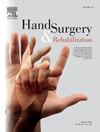Comparing the long-term results of Oberlin II versus intercostal neurotization for elbowflexion restoration (Prospective study)
IF 1
4区 医学
Q4 ORTHOPEDICS
引用次数: 0
Abstract
Background
Restoring elbow flexion following brachial plexus injury (BPI) is essential for improving arm function and quality of life in adults. This study aimed to compare the efficacy of Oberlin II and intercostal nerve (ICN) neurotization techniques for restoring elbow flexion in adults with upper and middle trunk brachial plexus palsy.
Methods
This prospective study included 36 patients aged 18 to 50 years with traumatic upper and middle trunk brachial plexus palsy. The patients were divided into two groups: Group A consisted of 19 patients who underwent the Oberlin II procedure, while Group B included 17 patients treated with ICN neurotization. All patients were followed for at least 60 months.
Results
Muscle reactivation occurred significantly earlier in the Oberlin II group compared to the ICN neurotization group (P = 0.012). Muscle strength grading also showed significant differences, with a higher proportion of patients achieving grade 4 and 4+ strength in the Oberlin II group compared to the ICN neurotization group (P = 0.041).
Conclusions
The Oberlin II neurotization technique demonstrated superior efficacy in restoring elbow flexion following BPI compared to ICN neurotization. It resulted in earlier muscle reactivation and higher levels of muscle strength, with a greater proportion of patients achieving grades 4 and 4+ strength.
Oberlin II与肋间神经化治疗肘关节屈曲恢复:一项前瞻性研究。
背景:臂丛神经损伤(BPI)后肘关节屈曲恢复是改善成人手臂功能和生活质量的必要条件。本研究旨在比较Oberlin II和肋间神经(ICN)神经化技术在恢复成人上肢和中肢臂丛麻痹患者肘关节屈曲的疗效。方法:本前瞻性研究纳入36例18 ~ 50岁外伤性臂丛中上干麻痹患者。患者分为两组:A组包括19例接受Oberlin II手术的患者,B组包括17例接受ICN神经化的患者。所有患者随访至少60个月。结果:Oberlin II组肌肉再激活明显早于ICN神经化组(P = 0.012)。肌力分级也有显著差异,与ICN神经化组相比,Oberlin II组达到4级和4+级的患者比例更高(P = 0.041)。结论:与ICN神经化相比,Oberlin II神经化技术在BPI术后肘关节屈曲恢复方面表现出优越的疗效。它导致更早的肌肉再激活和更高水平的肌肉力量,更大比例的患者达到4级和4+级力量。
本文章由计算机程序翻译,如有差异,请以英文原文为准。
求助全文
约1分钟内获得全文
求助全文
来源期刊

Hand Surgery & Rehabilitation
Medicine-Surgery
CiteScore
1.70
自引率
27.30%
发文量
0
审稿时长
49 days
期刊介绍:
As the official publication of the French, Belgian and Swiss Societies for Surgery of the Hand, as well as of the French Society of Rehabilitation of the Hand & Upper Limb, ''Hand Surgery and Rehabilitation'' - formerly named "Chirurgie de la Main" - publishes original articles, literature reviews, technical notes, and clinical cases. It is indexed in the main international databases (including Medline). Initially a platform for French-speaking hand surgeons, the journal will now publish its articles in English to disseminate its author''s scientific findings more widely. The journal also includes a biannual supplement in French, the monograph of the French Society for Surgery of the Hand, where comprehensive reviews in the fields of hand, peripheral nerve and upper limb surgery are presented.
Organe officiel de la Société française de chirurgie de la main, de la Société française de Rééducation de la main (SFRM-GEMMSOR), de la Société suisse de chirurgie de la main et du Belgian Hand Group, indexée dans les grandes bases de données internationales (Medline, Embase, Pascal, Scopus), Hand Surgery and Rehabilitation - anciennement titrée Chirurgie de la main - publie des articles originaux, des revues de la littérature, des notes techniques, des cas clinique. Initialement plateforme d''expression francophone de la spécialité, la revue s''oriente désormais vers l''anglais pour devenir une référence scientifique et de formation de la spécialité en France et en Europe. Avec 6 publications en anglais par an, la revue comprend également un supplément biannuel, la monographie du GEM, où sont présentées en français, des mises au point complètes dans les domaines de la chirurgie de la main, des nerfs périphériques et du membre supérieur.
 求助内容:
求助内容: 应助结果提醒方式:
应助结果提醒方式:


